Drought Detection over Papua New Guinea Using Satellite-Derived Products
Abstract
:1. Introduction
2. Materials and Methods
2.1. Study Area
2.2. Datasets
2.2.1. Validation Study
2.2.2. Case Study for the 2015–2016 El Niño-Induced Drought
- The SPI is a commonly used index to characterise drought. It compares how different the rainfall observed is to the average for that period by measuring the number of standard deviations it is away from the mean [25]. Typically, values below −1.5 are considered “severely dry,” those below −2 are considered “extremely dry,” while values above 2 are indicative of “extremely wet” conditions [25,26].
- The NDVI is a measure of the photosynthesis in vegetation. The NOAA AVHRR satellite instrument can measure visible (VIS) and near-infrared (NIR) radiations reflected from and emitted by the surface [27]. The NDVI is calculated based on the difference in intensity between these two wavelengths. This difference is then normalised by the sum of the intensities of wavelengths [27]. Soils do not demonstrate much difference between the two wavelengths while a large difference is taken to be indicative of dense green vegetation.
- 3.
- The VHI is another index that characterises plant health. It is composed of the Vegetation Condition Index (VCI) and the Temperature Condition Index (TCI). The VCI is NDVI normalised by its climatological range while the TCI is the land surface temperature (LST) normalised by its climatological range. The equation for VHI along with its components are shown below.
- 4.
- Outgoing longwave radiation (OLR) is a measure of energy emitted to space by Earth’s surface and atmosphere and is a component of the radiation budget [33]. It can act as a proxy for clouds and rainfall as clouds reduce the amount of radiation that can be detected [34]. Normalised anomalies can be used as an indicator of drought with positive OLR anomalies being indicative of increased clear and dry conditions and negative OLR anomalies being indicative of increased clouds and rainfall.
- 5.
- Soil moisture plays an important role in energy and water exchange between the surface and the atmosphere. Satellite-derived estimates of soil moisture are based on using microwaves to measure the emissivity of the surface and then linking this to conductivity and moisture [37]. Irrigation in PNG is very limited with most crops being rainfed [38]. As a result, it is reasonable to expect that remotely-sensed soil moisture is indicative of natural soil moisture.
2.3. Method
2.3.1. Validation Study
2.3.2. Case Study for the 2015–2016 El Niño-Induced Drought
3. Results
3.1. Validation Study
3.1.1. Point-Based Comparison
3.1.2. Gridded Comparison
3.1.3. Seasonal and Geographical Comparison
3.2. Case Study for the 2015–2016 El Niño-Induced Drought
3.2.1. Rainfall
3.2.2. Standardized Precipitation Index (SPI)
3.2.3. Normalized Difference Vegetation Index (NDVI)
3.2.4. Vegetation Health Index (VHI)
3.2.5. Soil Moisture
3.2.6. Outgoing Longwave Radiation (OLR)
3.2.7. Areal-Averaged Variables from 2014 to 2016
4. Discussion
4.1. Validation Study
4.2. Case Study for the 2015–2016 El Niño-Induced Drought
5. Conclusions
Author Contributions
Funding
Acknowledgments
Conflicts of Interest
Appendix A
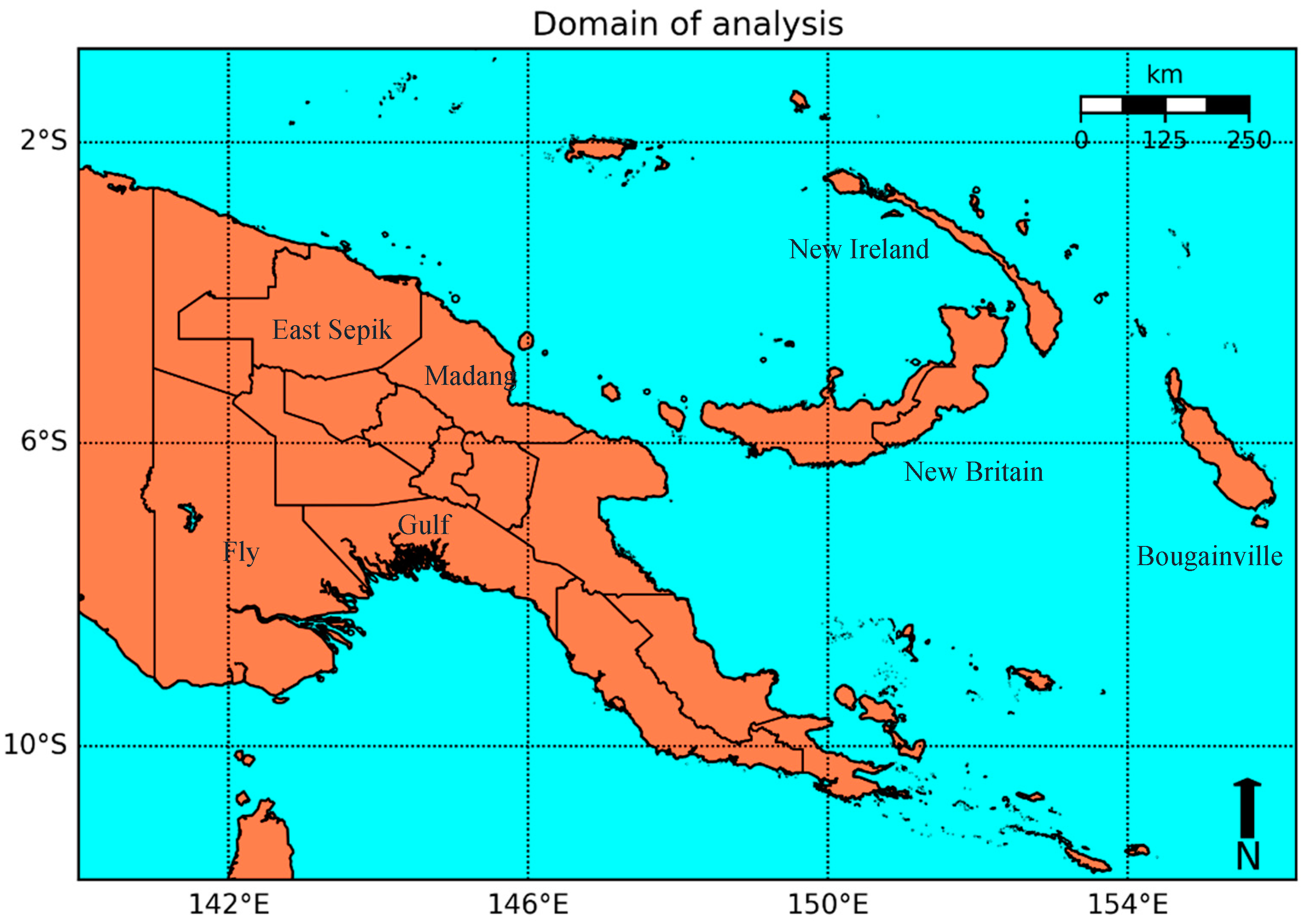
References
- Ready for the Dry Years (2019). ST/ESCAP/2851. Available online: https://www.unescap.org/publications/ready-dry-years-building-resilience-drought-south-east-asia (accessed on 25 October 2020).
- McGree, S.; Schreider, S.; Kuleshov, Y. Trends and variability in droughts in the Pacific Islands and Northeast Australia. J. Clim. 2016, 29, 8377–8397. [Google Scholar] [CrossRef]
- Smith, I.; Moise, A.; Inape, K.; Murphy, B.; Colman, R.; Power, S.; Chung, C. ENSO-related rainfall changes over the New Guinea region. J. Geophys. Res.-Atmos. 2013, 118, 10665–10675. [Google Scholar] [CrossRef]
- Kuleshov, Y.; McGree, S.; Jones, D.; Charles, A.; Cottrill, A.; Prakash, B.; Atalifo, T.; Nihmei, S.; Seuseu, F. Extreme weather and climate events and their impacts on island countries in the western Pacific: Cyclones, floods and droughts. Atmos. Clim. Sci. 2014, 4, 803–818. [Google Scholar] [CrossRef] [Green Version]
- Kuleshov, Y.; Inape, K.; Watkins, A.B.; Bear-Crozier, A.; Chua, Z.-W.; Xie, P.; Kubota, T.; Tashima, T.; Stefanski, R.; Kurino, T. Climate Risk and Early Warning Systems (CREWS) for Papua New Guinea. In Drought–Detection and Solutions; IntechOpen: London, UK, 2020; pp. 147–168. [Google Scholar] [CrossRef] [Green Version]
- El Niño 2015/2016 Post Drought Assessment: Report of the Inter Agency Post Drought Assessment in Papua New Guinea September 2016 Papua New Guinea|ReliefWeb (n.d.). Available online: https://reliefweb.int/report/papua-new-guinea/el-ni-o-20152016-post-drought-assessment-report-inter-agency-post-drought (accessed on 21 January 2020).
- Cai, W.; Santoso, A.; Wang, G.; Yeh, S.-W.; An, S.-I.; Cobb, K.M.; Wu, L. ENSO and greenhouse warming. Nat. Clim. Chang. 2015, 5, 849–859. [Google Scholar] [CrossRef]
- Kuleshov, Y.; Kurino, T.; Kubota, T.; Tashima, T.; Xie, P. WMO Space-based Weather and Climate Extremes Monitoring Demonstration Project (SEMDP): First Outcomes of Regional Cooperation on Drought and Heavy Precipitation Monitoring for Australia and Southeast Asia. In Rainfall Extremes, Distribution and Properties; IntechOpen: London, UK, 2019; pp. 51–57. [Google Scholar] [CrossRef] [Green Version]
- Derin, Y.; Yilmaz, K.K. Evaluation of multiple satellite-based precipitation products over complex topography. J. Hydrometeorol. 2014, 15, 1498–1516. [Google Scholar] [CrossRef] [Green Version]
- Ebert, E.E.; Janowiak, J.E.; Kidd, C. Comparison of near-real-time precipitation estimates from satellite observations and numerical models. B Am. Meteorol. Soc. 2007, 88, 47–64. [Google Scholar] [CrossRef] [Green Version]
- Joyce, R.J.; Janowiak, J.E.; Arkin, P.A.; Xie, P. CMORPH: A Method that Produces Global Precipitation Estimates from Passive Microwave and Infrared Data at High Spatial and Temporal Resolution. J. Hydrometeorol. 2004, 5, 487–503. [Google Scholar] [CrossRef]
- Okamoto, K.; Ushio, T.; Iguchi, T.; Takahashi, N.; Iwanami, K. The Global Satellite Mapping of Precipitation (GSMaP) project. Int. Geosci. Remote Sens. Symp. (IGARSS) 2005, 5, 3414–3416. [Google Scholar] [CrossRef]
- Dinku, T.; Ceccato, E.; Grover-Kopec, E.; Lemma, M.; Connor, S.J.; Ropelewski, C.F. Validation of satellite rainfall products over East Africa’s complex topography. Int. J. Remote Sens. 2007, 28, 1503–1526. [Google Scholar] [CrossRef]
- Chua, Z.; Kuleshov, Y.; Watkins, A. Evaluation of satellite precipitation estimates over Australia. Remote Sens. 2020, 12, 678. [Google Scholar] [CrossRef] [Green Version]
- McVicar, T.R.; Bierwirth, P.N. Rapidly assessing the 1997 drought in papua new guinea using composite avhrr imagery. Int. J. Remote Sens. 2001, 22, 2109–2128. [Google Scholar] [CrossRef]
- Chepkemoi, J. Island Countries of the World. Available online: https://www.worldatlas.com/articles/which-are-the-island-countries-of-the-world.html (accessed on 29 November 2018).
- Bismarck Range|Mountains, Papua New Guinea|Britannica. (n.d.). Available online: https://www.britannica.com/place/Bismarck-Range (accessed on 24 January 2020).
- East Asia/Southeast Asia: Papua New Guinea—The World Factbook Central Intelligence Agency. (n.d.). Available online: https://www.cia.gov/library/publications/the-world-factbook/geos/pp.html (accessed on 16 November 2020).
- Smith, I.N.; Moise, A.F.; Colman, R.A. Large-scale circulation features in the tropical western Pacific and their representation in climate models. J. Geophys. Res.-Atmos. 2012, 117. [Google Scholar] [CrossRef]
- Chang, C.P.; Wang, Z.; McBride, J.; Liu, C.H. Annual cycle of Southeast Asia-Maritime Continent rainfall and the asymmetric monsoon transition. J. Clim. 2005, 18, 287–301. [Google Scholar] [CrossRef]
- Amante, C.; Eakins, B.W. ETOPO1 1 Arc-Minute Global Relief Model: Procedures, Data Sources and Analysis. NOAA Technical Memorandum NESDIS NGDC-24. March 2009; p. 19. Available online: http://www.ngdc.noaa.gov/mgg/global/global.html (accessed on 25 October 2020).
- Global Satellite Mapping of Precipitation (GSMaP) for GPM Algorithm Theoretical Basis Document Version 6. Available online: https://eorc.jaxa.jp/GPM/doc/algorithm/GSMaPforGPM_20140902 (accessed on 14 September 2019).
- Xie, P.; Joyce, R.; Wu, S.; Yoo, S.H.; Yarosh, Y.; Sun, F.; Lin, R. Reprocessed, bias-corrected CMORPH global high-resolution precipitation estimates from 1998. J. Hydrometeorol. 2017, 18, 1617–1641. [Google Scholar] [CrossRef]
- Hersbach, H.; Bell, B.; Berrisford, P.; Horányi, A.; Sabater, J.M.; Nicolas, J.; Dee, D. Global reanalysis: Goodbye ERA-Interim, hello ERA5. Ecmwf. Newsl. 2019, 159, 17–24. [Google Scholar] [CrossRef]
- Keyantash, J.; Dracup, J.A. The quantification of drought: An evaluation of drought indices. B Am. Meteorol. Soc. 2002, 83, 1167–1180. [Google Scholar] [CrossRef]
- Standardized Precipitation Index (SPI)|NCAR Climate Data Guide. (n.d.). Available online: https://climatedataguide.ucar.edu/climate-data/standardized-precipitation-index-spi (accessed on 21 February 2020).
- Measuring Vegetation (NDVI & EVI). (n.d.). Available online: https://earthobservatory.nasa.gov/features/MeasuringVegetation/measuring_vegetation_2.php (accessed on 21 January 2020).
- Karnieli, A.; Bayasgalan, M.; Bayarjargal, Y.; Agam, N.; Khudulmur, S.; Tucker, C.J. Comments on the use of the Vegetation Health Index over Mongolia. Int. J. Remote Sens. 2006, 27, 2017–2024. [Google Scholar] [CrossRef]
- Cámara-Leret, R.; Raes, N.; Roehrdanz, P.; de Fretes, Y.; Heatubun, C.D.; Roeble, L.; Hannah, L. Climate change threatens New Guinea’s biocultural heritage. Sci. Adv. 2019, 5, eaaz1455. [Google Scholar] [CrossRef] [Green Version]
- Karnieli, A.; Agam, N.; Pinker, R.T.; Anderson, M.; Imhoff, M.L.; Gutman, G.G.; Goldberg, A. Use of NDVI and Land Surface Temperature for Drought Assessment: Merits and Limitations. J. Clim. 2010, 23, 618–633. [Google Scholar] [CrossRef]
- Kogan, F. World droughts in the new millennium from avhrr-based vegetation health indices. Eos, Trans. Am. Geophys. Union 2002, 83, 557. [Google Scholar] [CrossRef]
- Yoon, D.-H.; Nam, W.-H.; Lee, H.-J.; Hong, E.-M.; Feng, S.; Wardlow, B.D.; Kim, D.-E. Agricultural Drought Assessment in East Asia Using Satellite-Based Indices. Remote Sens. 2020, 12, 444. [Google Scholar] [CrossRef] [Green Version]
- Outgoing Longwave Radiation (OLR): HIRS|NCAR Climate Data Guide. (n.d.). Available online: https://climatedataguide.ucar.edu/climate-data/outgoing-longwave-radiation-olr-hirs (accessed on 21 January 2020).
- Chelliah, M.; Arkin, P. Large-Scale Interannual Variability of Monthly Outgoing Longwave Radiation Anomalies over the Global Tropics. J. Clim. 1992. [Google Scholar] [CrossRef] [Green Version]
- Ellingson, R.G.; Hai-Tien Lee Yanuk, D.; Gruber, A. Validation of a technique for estimating outgoing longwave radiation from HIRS radiance observations. J. Atmos. Ocean. Technol. 1994, 11, 357–365. [Google Scholar] [CrossRef] [Green Version]
- Lee, H.T.; Gruber, A.; Ellingson, R.G.; Laszlo, I. Development of the HIRS outgoing longwave radiation climate dataset. J. Atmos. Ocean. Technol. 2007, 24, 2029–2047. [Google Scholar] [CrossRef] [Green Version]
- Jensen, K. (n.d.). Soil Moisture Operational Product System (SMOPS) Algorithm Theoretical Basis Document. Available online: https://www.ospo.noaa.gov/Products/land/smops/figures/SMOPS_ATBD_v3.0.pdf (accessed on 25 October 2020).
- Aquastat Country Profile Papua New Guinea; Food and Agriculture Organization of the United Nations: Rome, Italy, 2011.
- Evaluation of Australia’s Response to El Niño Drought and Frosts in PNG 2015-17 INL847. (n.d.). Available online: www.iodparc.com (accessed on 21 January 2020).
- Ning, S.; Song, F.; Udmale, P.; Jin, J.; Thapa, B.; Ishidaira, H. Error Analysis and Evaluation of the Latest GSMap and IMERG Precipitation Products over Eastern China. Adv. Meteorol. 2017, 2017, 1–16. [Google Scholar] [CrossRef] [Green Version]
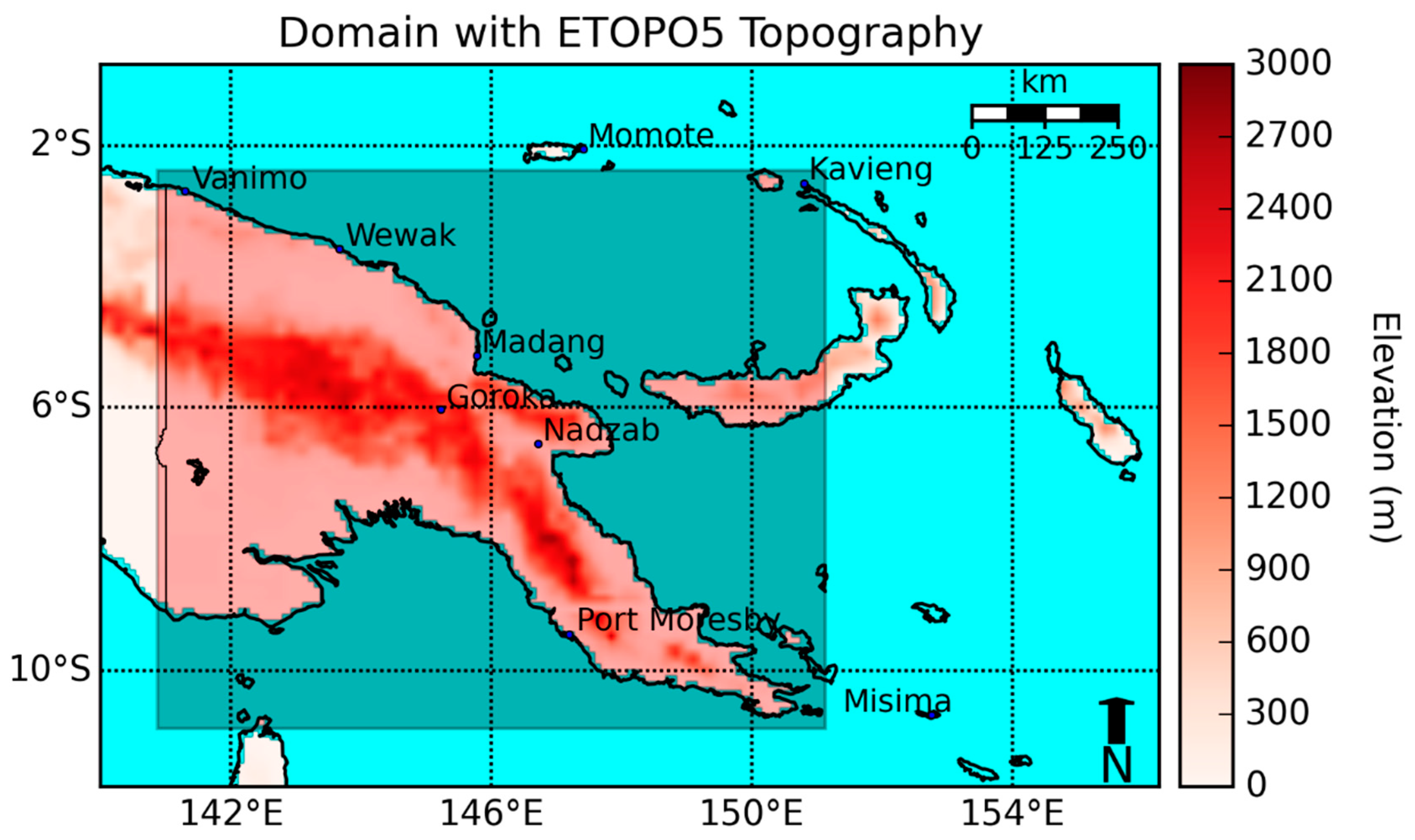




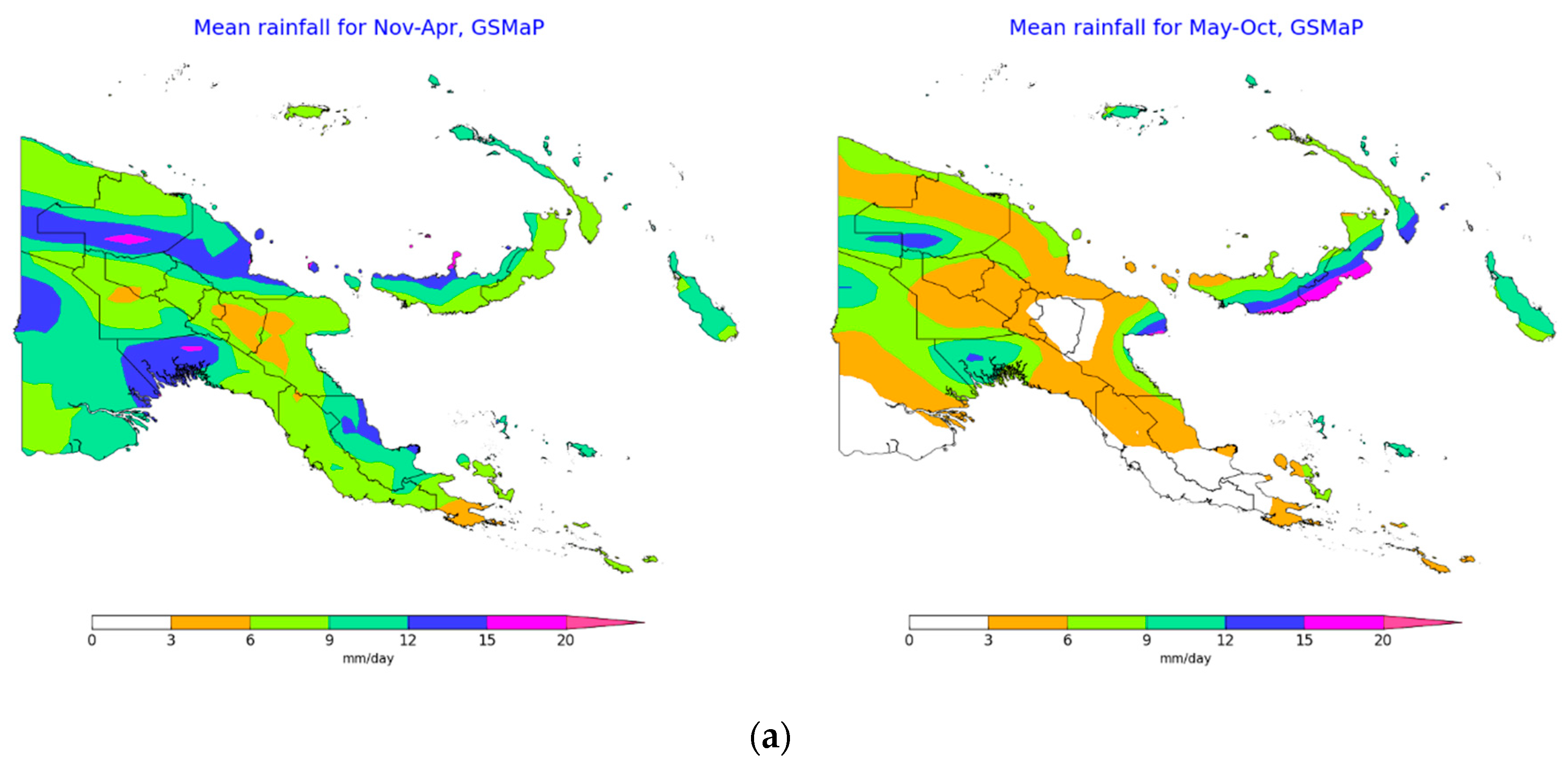
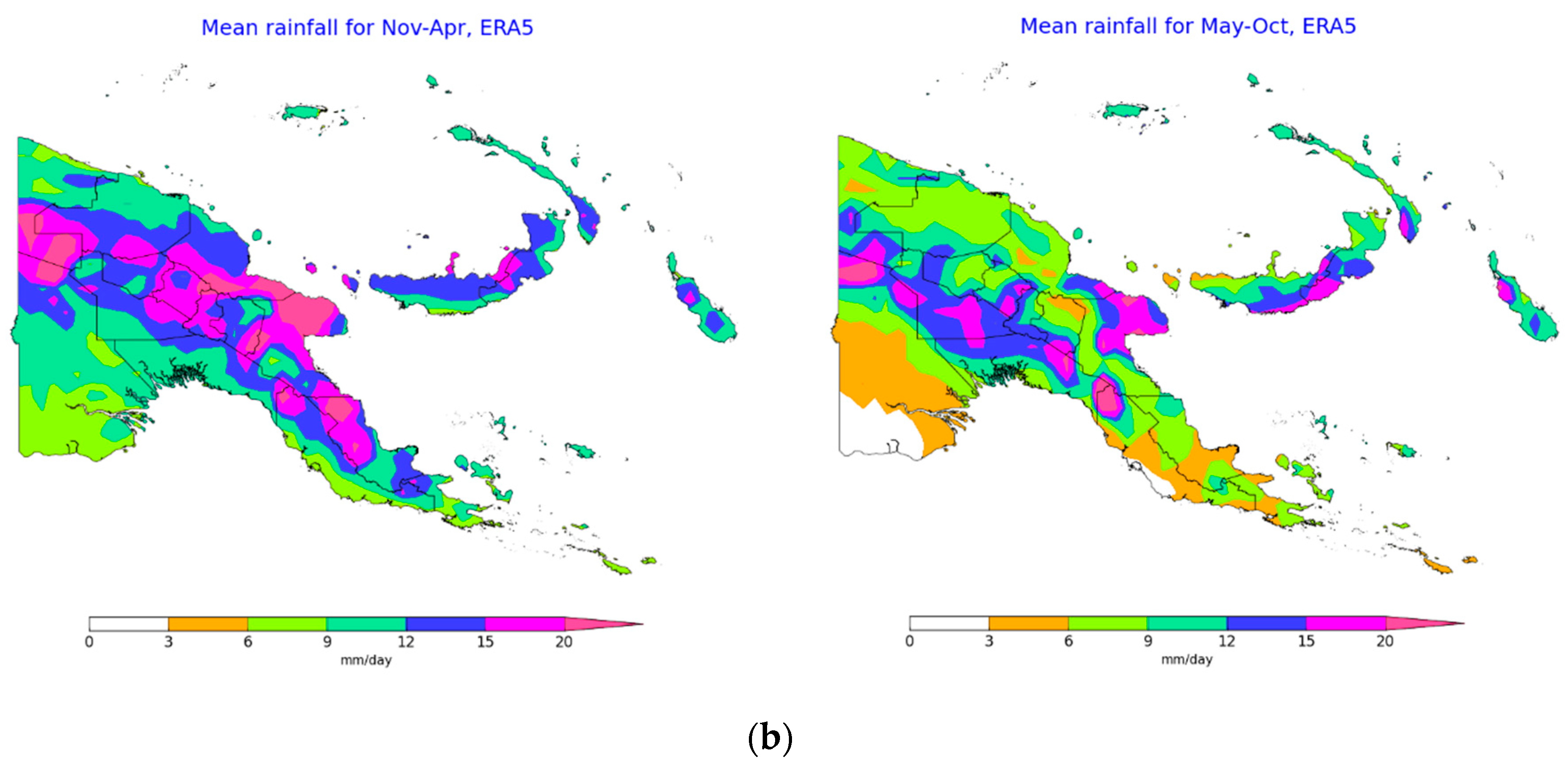


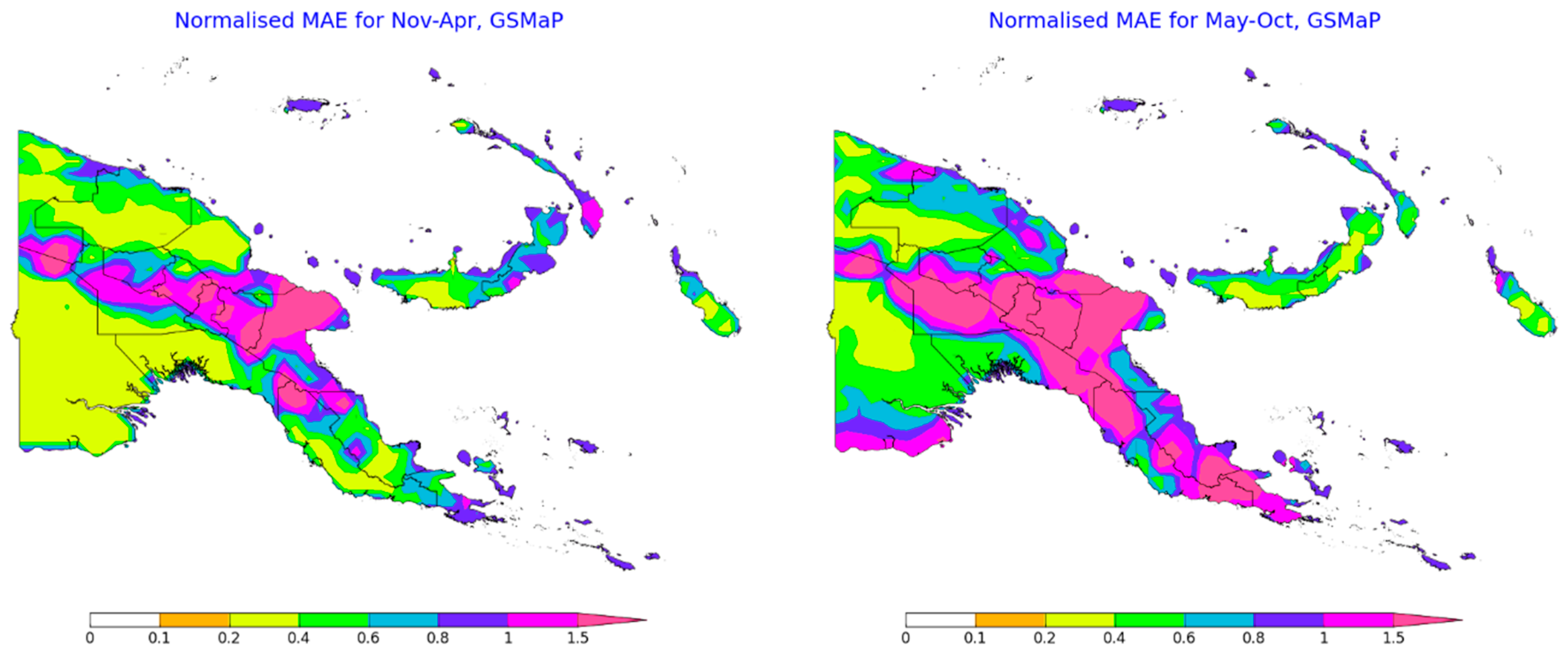

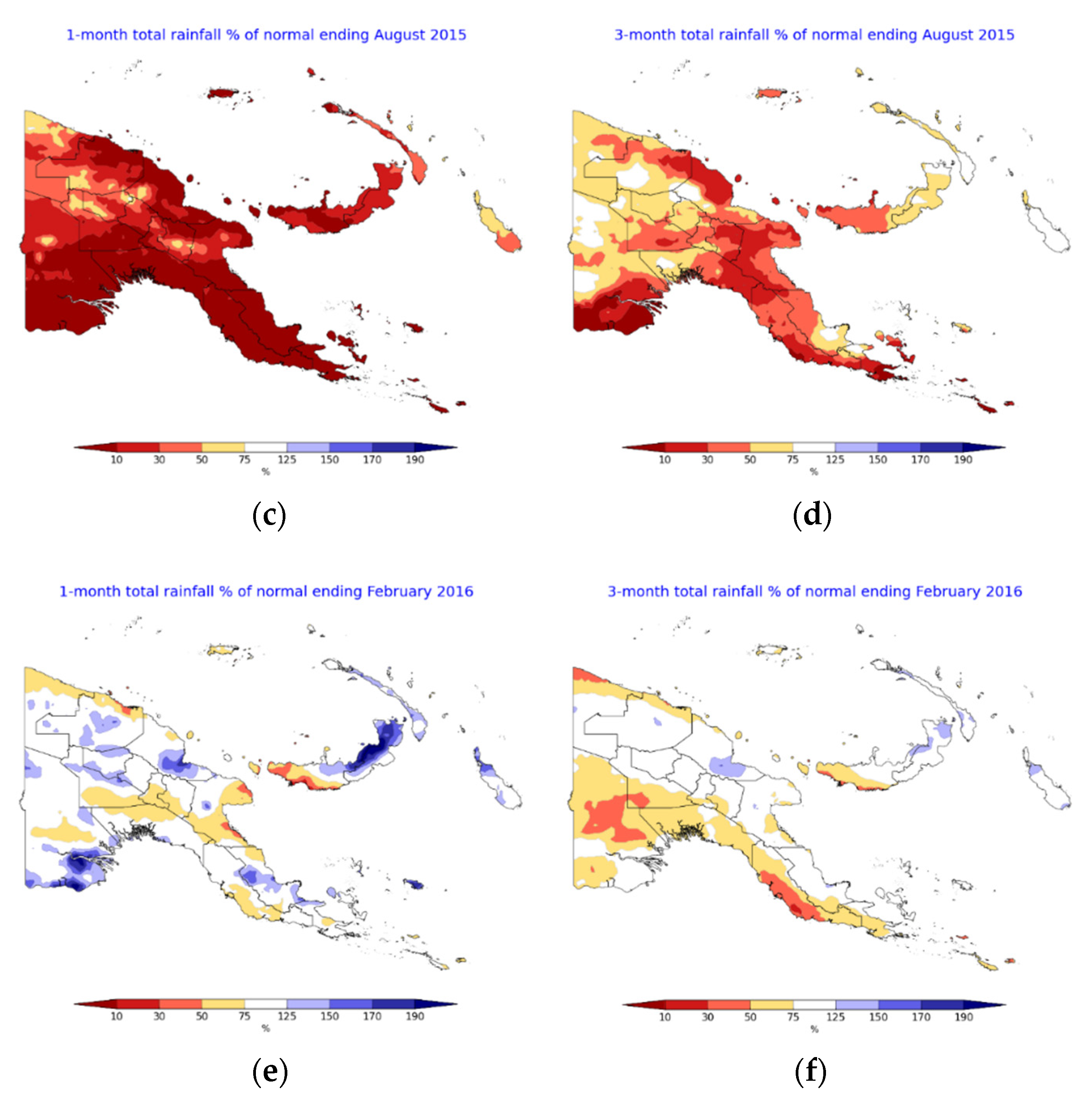
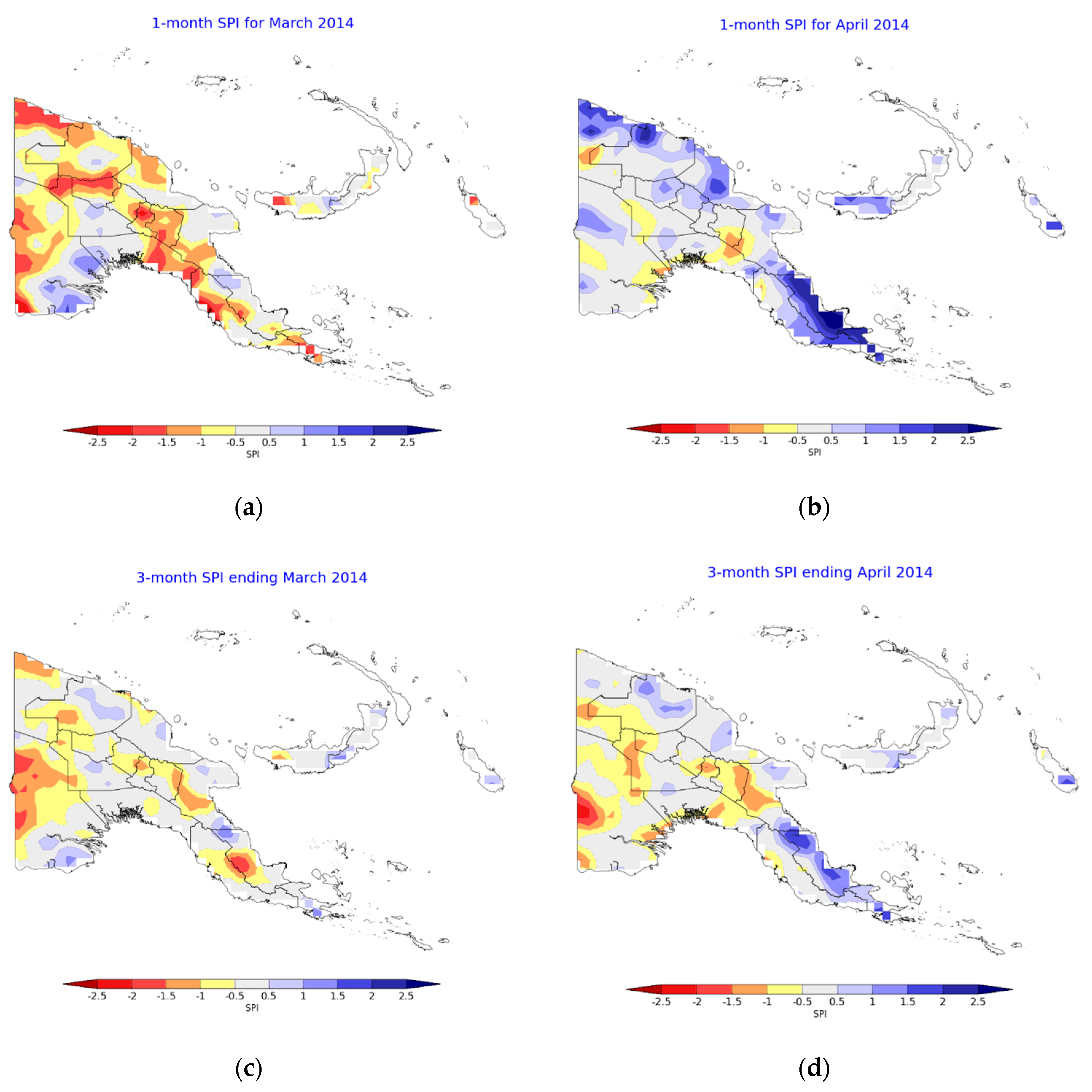
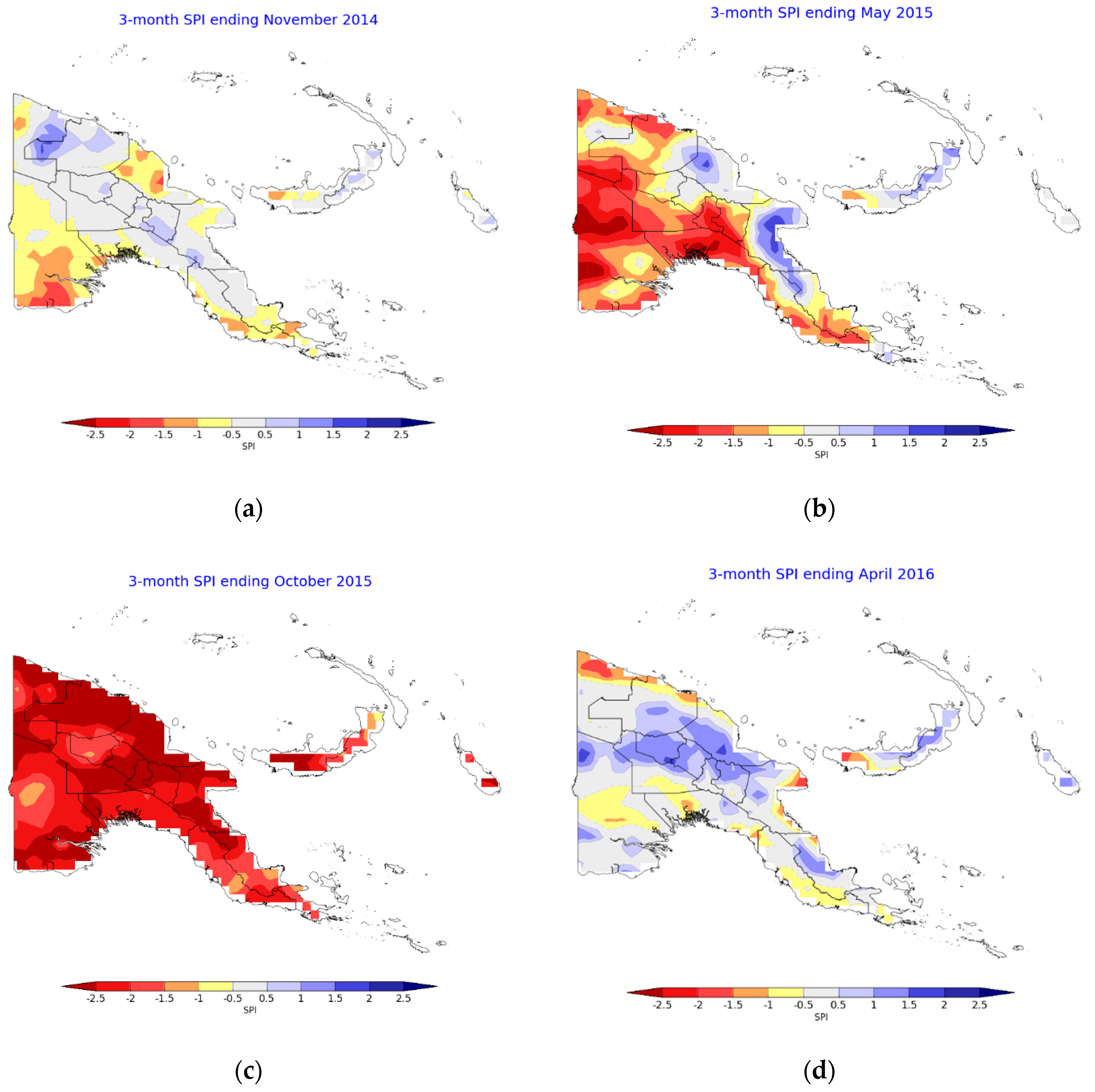
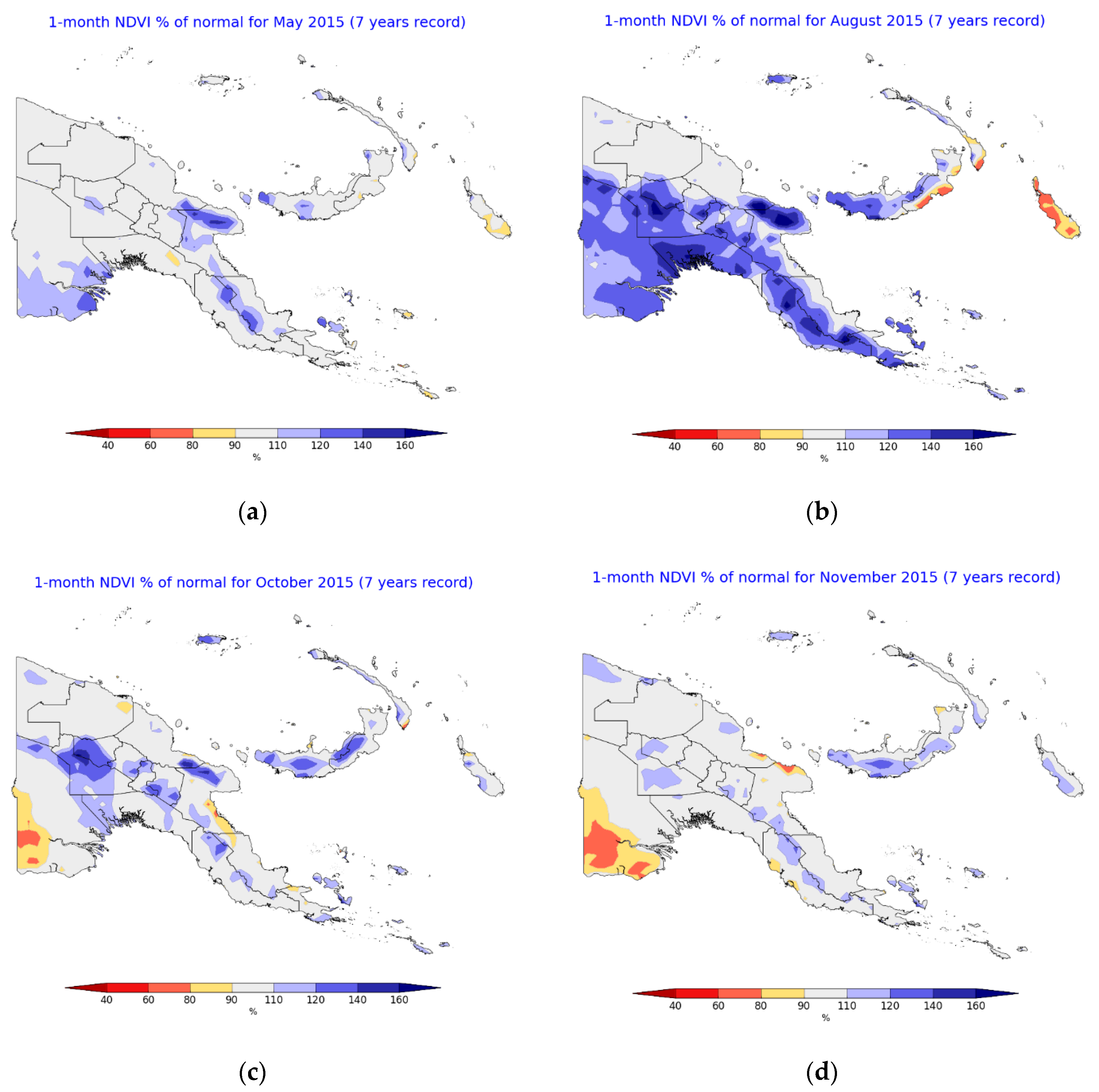
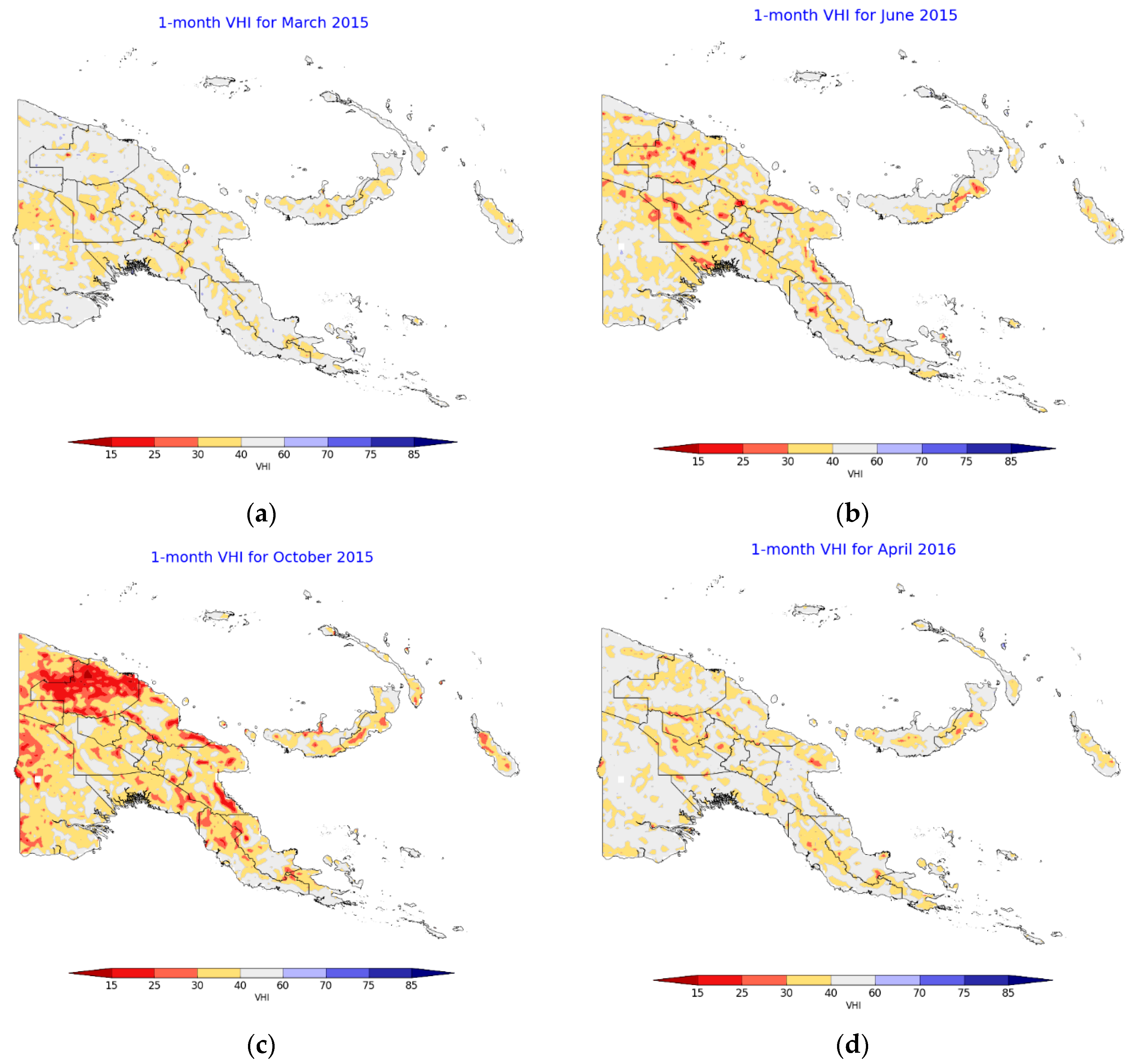


| Dataset | Resolution (°) | Start Time of Datasets | Latitude Range (°) | Longitude Range (°) |
|---|---|---|---|---|
| CMORPH BLD | 0.25 | January 1998 | (−45, 40) | (50, 200) |
| CMORPH CRT | 0.25 | January 1998 | (−45, 40) | (50, 200) |
| GSMaP | 0.10 | April 2000 | (−45, 40) | (50, 200) |
| ERA5 | 0.25 | January 1979 | Global | Global |
| Metric | Equation | Range | Perfect Value | Unit |
|---|---|---|---|---|
| Mean bias (MB) | (−∞, ∞) | 0 | mm/day | |
| Mean average error (MAE) | [0, ∞) | 0 | mm/day | |
| Root-mean-square-error (RMSE) | [0, ∞) | 0 | mm/day | |
| Pearson correlation coefficient (R) | [−1, 1] | 1 |
Publisher’s Note: MDPI stays neutral with regard to jurisdictional claims in published maps and institutional affiliations. |
© 2020 by the authors. Licensee MDPI, Basel, Switzerland. This article is an open access article distributed under the terms and conditions of the Creative Commons Attribution (CC BY) license (http://creativecommons.org/licenses/by/4.0/).
Share and Cite
Chua, Z.-W.; Kuleshov, Y.; Watkins, A.B. Drought Detection over Papua New Guinea Using Satellite-Derived Products. Remote Sens. 2020, 12, 3859. https://doi.org/10.3390/rs12233859
Chua Z-W, Kuleshov Y, Watkins AB. Drought Detection over Papua New Guinea Using Satellite-Derived Products. Remote Sensing. 2020; 12(23):3859. https://doi.org/10.3390/rs12233859
Chicago/Turabian StyleChua, Zhi-Weng, Yuriy Kuleshov, and Andrew B. Watkins. 2020. "Drought Detection over Papua New Guinea Using Satellite-Derived Products" Remote Sensing 12, no. 23: 3859. https://doi.org/10.3390/rs12233859
APA StyleChua, Z.-W., Kuleshov, Y., & Watkins, A. B. (2020). Drought Detection over Papua New Guinea Using Satellite-Derived Products. Remote Sensing, 12(23), 3859. https://doi.org/10.3390/rs12233859





